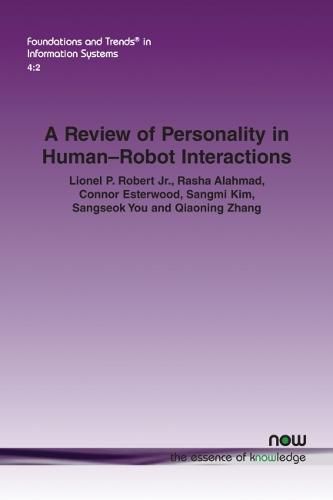Readings Newsletter
Become a Readings Member to make your shopping experience even easier.
Sign in or sign up for free!
You’re not far away from qualifying for FREE standard shipping within Australia
You’ve qualified for FREE standard shipping within Australia
The cart is loading…






This title is printed to order. This book may have been self-published. If so, we cannot guarantee the quality of the content. In the main most books will have gone through the editing process however some may not. We therefore suggest that you be aware of this before ordering this book. If in doubt check either the author or publisher’s details as we are unable to accept any returns unless they are faulty. Please contact us if you have any questions.
A Review of Personality in Human-Robot Interactions reviews the literature on personality and embodied physical action (EPA) robots. This monograph investigates the current state of human-robot personality research, discusses the unique role of personality in human-robot research, and offers guidance for future research. A Review of Personality in Human-Robot Interactions offers several contributions to the literature. First, it presents a conceptual integrated model of the literature on personality in human-robot literature. Second, it highlights four thrust areas in the literature. These areas include: (1) Human Personality and HRI, (2) Robot Personality and HRI, (3) Robot Personality and HRI, and (4) Factors Impacting Robot Personality. Third, it derives and presents major insights from the literature. Finally, it identifies gaps in the literature that need to be addressed. After the introduction, Section 2 presents the relevant literature including the inclusion and exclusion criteria for articles. Section 3 presents and discusses Thrust Area 1: Human Personality and HRI. In sections 4, 5, and 6, a similar discussion takes place for Thrust Area 2: Robot Personality and HRI, Thrust Area 3: Robot Personality and HRI, and Thrust Area 4: Factors Impacting Robot Personality, respectively. Section 7 follows with a discussion on the way forward, focusing on the opportunities for personality research in human-robot interaction.
$9.00 standard shipping within Australia
FREE standard shipping within Australia for orders over $100.00
Express & International shipping calculated at checkout
Stock availability can be subject to change without notice. We recommend calling the shop or contacting our online team to check availability of low stock items. Please see our Shopping Online page for more details.
This title is printed to order. This book may have been self-published. If so, we cannot guarantee the quality of the content. In the main most books will have gone through the editing process however some may not. We therefore suggest that you be aware of this before ordering this book. If in doubt check either the author or publisher’s details as we are unable to accept any returns unless they are faulty. Please contact us if you have any questions.
A Review of Personality in Human-Robot Interactions reviews the literature on personality and embodied physical action (EPA) robots. This monograph investigates the current state of human-robot personality research, discusses the unique role of personality in human-robot research, and offers guidance for future research. A Review of Personality in Human-Robot Interactions offers several contributions to the literature. First, it presents a conceptual integrated model of the literature on personality in human-robot literature. Second, it highlights four thrust areas in the literature. These areas include: (1) Human Personality and HRI, (2) Robot Personality and HRI, (3) Robot Personality and HRI, and (4) Factors Impacting Robot Personality. Third, it derives and presents major insights from the literature. Finally, it identifies gaps in the literature that need to be addressed. After the introduction, Section 2 presents the relevant literature including the inclusion and exclusion criteria for articles. Section 3 presents and discusses Thrust Area 1: Human Personality and HRI. In sections 4, 5, and 6, a similar discussion takes place for Thrust Area 2: Robot Personality and HRI, Thrust Area 3: Robot Personality and HRI, and Thrust Area 4: Factors Impacting Robot Personality, respectively. Section 7 follows with a discussion on the way forward, focusing on the opportunities for personality research in human-robot interaction.